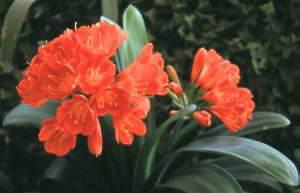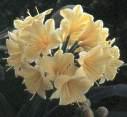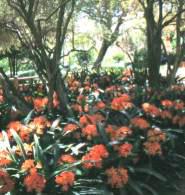Clivia miniata
Clivia miniata (Lindl.) Regel
Family: Amaryllidaceae
Common names: bush lily (Eng.); boslelie (Afr.); umayime (Zulu)
Introduction
A striking plant, an international star, with its dark green leaves and trumpet-shaped orange flowers, Clivia miniata is the ideal plant for the shade garden or for containers.

Description
Description
Clivia miniata is a clump-forming perennial with dark green, strap-shaped leaves which arise from a fleshy underground stem. The flowering heads of brilliant orange (rarely yellow), trumpet-shaped flowers appear mainly in spring (August to November) but also sporadically at other times of the year. The deep green, shiny leaves are a perfect foil for the masses of orange flowers.

Distribution and habitat
Distribution description
The genus Clivia is endemic to southern Africa, meaning that they do not occur naturally anywhere else in the world! The wild bush lily grows in the forests of Kwazulu-Natal, Eastern Cape, Mpumalanga and Swaziland. The habitat may vary from subtropical coastal forest to ravines in high-altitude forest. It grows in dappled shade, often in large colonies. The soil is well-drained and humus rich. Occasionally they may be found growing in the fork of a tree.
Derivation of name and historical aspects
History
The genus name Clivia is after the Duchess of Northumberland, Lady Charlotte Clive, who first cultivated and flowered the type specimen in England. The species epithet miniata means the colour of red lead, referring to the flowers.
The world's love affair with South Africa's clivias began in the 1800s when specimens were sent back to England from Kwazulu-Natal. In Victorian times this beautiful plant was very popular for indoor use in England and Europe. The discovery of the yellow-flowered Clivia miniata (C. miniata var. citrina) in the late 1800s fuelled an interest which still persists today.

Part of the fascination has been with the breeding of clivias, both amongst the four species (C. nobilis, C. gardenii, C. caulescens, C. miniata ) and between forms and colours within the species. Breeders select for specific traits in each generation to produce pronounced qualities such as huge, broad petalled flowers, red, yellow or apricot coloration, broad leaves, fan-shaped leaf arrangement, variegation, dwarfism and many others. Internationally, the most advanced breeding of Cliva is happening in the Far East, most notably Japan.
Uses
Use
Sadly, in many areas colonies of wild bush lilies have been destroyed by harvesting for traditional medicine and also by plant collectors. The rhizomes are reportedly extremely toxic but are used medicinally for various purposes.
Growing Clivia miniata
Grow
Clivia miniata is easily cultivated and very rewarding. Plant in dappled shade — clivias are sensitive to sunlight and will burn easily. Plant in well-composted soil, which will also help with soil-water retention during dry periods. The plants should be watered regularly during the summer months, which is their growing season. Watering can be reduced during winter and the plants will tolerate fairly long dry periods. Bush lilies are spectacular container subjects. They should be grown in a well-drained potting medium which has plenty of compost added. This will also ensure good aeration which is another of their requirements. Clivias respond well to feeding in the summer months, either with slow-release fertiliser included in the potting mix or with a good liquid feed. Beds of established clivia can be given a granular fertiliser such as 3:1:5 or 2:3:2 and will benefit from a thick layer of organic mulch such as well-rotted compost, annually.

The bush lily is frost-tender and may be damaged if in a position that is exposed, especially to cold winds. It takes a long time for the damage to grow out if this happens, so it is best to select a sheltered site.
Clivia miniata can be propagated by seed or by removing suckers. The fruits are bright orange when ripe (or golden in the case of the yellow flowered plants). The pulp should be removed from the seed when you are ready to sow . The seeds are large with a pearly sheen and should be sown fresh for best results. (Remember to wash your hands very well after cleaning the seed.) Sow the seed in deep trays in sifted seedling mix which has been sterilised. Simply press the seeds gently into the mix until they are almost flush with the surface. The medium should be kept moist but since the seeds take a long time to germinate (four to six weeks), keep an eye out for algal growths on the surface which will deprive the germinating seeds of oxygen. They may remain in the trays for up to two years before they are large enough to plant on.
Large clumps can be split up using two forks to lever them apart or individual plants can be removed using a clean, sharp spade. These plants may not flower for a couple of seasons after splitting. This method of propagation is a reliable method of obtaining plants which are true to colour which is a problem when using seed. A yellow clivia will not necessarily yield yellow seedlings!
References
- Duncan, GD. 1999. Grow Clivias. Kirstenbosch Gardening Series. National Botanical Institute. Cape Town.
- Pooley, E. 1998. A Field Guide to Wild Flowers of Kwazulu-Natal and the Eastern Region. Natal Flora Publications Trust. Durban
- Van Wyk, B-E, van Oudtshoorn, B & Gericke, N. 1997. Medicinal Plants of South Africa. Briza Publications, Pretoria.
Credits
Alice Aubrey
Witwatersrand National Botanical Garden
August 2001
Plant Attributes:
Plant Type: Bulb, Perennial
SA Distribution: Eastern Cape, KwaZulu-Natal, Mpumalanga
Soil type: Loam
Flowering season: Spring, Sporadic/All year
PH: Acid, Neutral
Flower colour: Yellow, Orange
Aspect: Shade
Gardening skill: Easy
Special Features:
Horticultural zones











Rate this article
Article well written and informative
Rate this plant
Is this an interesting plant?
Login to add your Comment
Back to topNot registered yet? Click here to register.